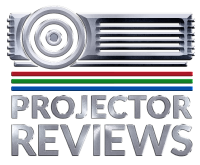Oh, how typical: 2000 hours in full power mode, and 3000 hours rated for low power. That has to be the "industry norm".
When it comes to replacing the lamp, the lamp door is on the bottom of the projector. That means you are going to have to unmount a celing mounted projector to change the lamp. That's a pain, but typical of most projectors. Problem is, its competition includes the BenQW10000 and the Panasonic PT-AE1000U, neither of which requires unmounting to change their lamps.
On the plus side, few people will need to run the HD81-LV in full lamp mode, so most of us will be working with the 3000 hour rating.
Review continues below this advertisement.
Optoma HD81-LV Projector Screen Recommendations
In this case, think of the HD81-LV as the proverbial 800 pound gorilla. What screen is best? Pretty much whatever it wants will work. I fully enjoyed the HD81-LV on my large Stewart Firehawk screen. When I took the HD81-LV into my testing room, I viewed it primarily on the Carada Brilliant White, but also on a HC Gray Elite motorized screen. With the 106" Brilliant White, the image was almost blinding in brightest modes, and black levels (i.e.. the letterbox), are starting to get a bit too light (still a dark gray). In other words, for movie viewing, the Carada Brilliant White at 106" is just too much with the iris open. However, dialing down the iris manually from the menus, reduced the overall brightness to acceptable levels, and the blacks in the letter box dropped back down in brightness to the usual very good near blacks that most consider perfectly acceptable. My Firehawk, being a gray surface, even with its large, 128" diagonal size, isn't even a challenge for the HD81-LV to fill. The result is a a dazzling image, even in low lamp mode, while filling the entire screen.
So the bottom line. Consider your ambient light situation. If you have side ambient light to deal with, a HC gray, like my Firehawk, or Elite's HC Gray, Da-lite's HC Da-Mat, etc. should serve well, because they can reject some of that side light. For a full court press - looking for maximum lumens, though, a StudioTek 130 has got to be a great choice. And for those needing a fixed wall screen, but running shy of cash, Carada's BW will work great for less than half the bucks.
If you are going really large screen - 123" to 160" diagonal, you can go either HC gray, or white, depending on your other room conditions. If you have the lighting control, though, and dark walls, I would tend to think the Stewart Studiotek 130, or Carada Brilliant White, is the way to go. And, should it be too bright, manually close down the iris until you are satisfied.
Optoma HD81-LV Calibration
Taking the HD81-LV from its relatively poor color settings to a great image, was actually pretty easy to do. I set up the User 1 mode, for movie watching, and I also adjusted User 2, but for maximum brightness, for dealing with lots of ambient light. I didn't run a full adjust for best settings for TV/HDTV, but rather eyeballed the User 2 settings I came up with, removed some green, and got a-not-quite-as-bright, but better looking image, than that for maximum brightness.
I won't even bother to give you the color temperature numbers before adjusting, as the picture was unacceptable.
| Contrast |
4 |
| Brightness |
3 |
| Color (saturation) |
2 |
| Gamma |
2 |
| Sharpness |
0 |
|
| Contrast |
|
| Red |
7 |
| Green |
-8 |
| Blue |
0 |
|
|
| Brightness |
|
| Red |
0 |
| Green |
-5 |
| Blue |
-1 |
|
| Lumens |
1474 |
| 100 IRE (white) |
6790K |
| 80 IRE (light gray) |
6418K |
| 50 IRE (med. gray) |
6400K |
| 30 IRE (dark gray) |
6335K |
|
With further adjusting, some of the slight shift from cooler (higher temp) to warmer (lower temp), could likely be reduced even more. These numbers however, result in a great looking image.
Maximum brightness: I really went to town, in setting up User 2, for maximum ambient light. I cranked up just about everything, especially Brilliant Color, and still had a watchable image. Mind you, if you have so much ambient light that you need every last lumen, you probably won't be too critical. Easy enough to compromise, and give up 20-30% of maximum brightness, and end up with a much better color balance for TV/sports. Ok, here's what I ended up with for maximum "horsepower":
Contrast: 8, Brightness: 3, Color: 0, Brilliant Color 6, Color Temp: Standard.
That resulted in a white (100IRE) temperature of 7472K, right about where you want it for TV/HDTV. However, the Standard selection for Color Temp was fairly heavy on the green.
Ideally, you would choose User for the Color Temp setting, instead of Standard, and get that green under control. Having high settings on Brilliant Color more than offset the slight drop in color saturation from setting Color to 0.
Optoma HD81-LV Image Noise
Overall image noise is very acceptable, and typical for a DLP. The Optoma HD-81-LV (like the HD81), performed well on the HQV test disk.
I did see significant noise when I cranked up the brightness, contrast, and Brilliant Color, to get the most lumens out of the HD81-LV for watching with a fair amount of ambient light. Even the noise filter barely put a dent into the noise. Of course, the way I had everything cranked up, is something you would only do in lighting conditions that no competitor could handle, so, a little noise is a relatively small price to pay.
Ok, time for a quick look at the Warranty, then the Summary section!

